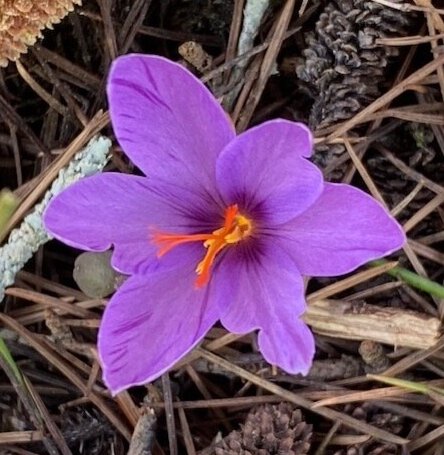What season is this?
The first predicted frost is always frightening. We weren’t confident enough to leave the garden as it was, so we prepared for the worst and filled the greenhouses, basement, and cold frames with our tenderest plants. Two frosty nights were expected, so we covered the cold frames both nights and were delighted to see that the frost touched only a few plants in the garden. Now we are in the midst of planting spring annuals. Although it is sad to pull up vigorous, healthy plants in order to plant seeds of our spring annuals, we do it now and hope to finish the job by week’s end.
Crocus medius
All is not work at this moment for fall crocuses are blooming and we take time to explore the garden. The rock garden blooms with Crocus tommasinianus, which have flowers in many shades of blue as well as white. The early, white flowering C. boryi has just about finished brightening up the metasequoia garden, white C. caspius appears all through the lawn near the deodara cedar. This is a delicately colored crocus with backs of their outer petals a shade of pale pink and the inner ones white. Showy purple C. tournefortii, growing nearby, is a vigorous species, which is the only one that remains open at night. Beneath a metasequoia and in the lawn nearby C. laevigatus covers the ground and brightens the lawn with flowers in many shades of purple. The latest crocus to open so far this fall is C. medius, a small, but intensely colored purple species. These plants increase from corms and seeds and multiply readily throughout the woods as well as in brighter, sunny places. Crocuses have a fascinating way of reproducing by seed. Bees do the necessary pollination and the ovary is below ground. Nothing more is visible until later when the seeds ripen at which time the ripe pod appears above ground with oblong pods filled with seeds. From that we could produce many more plants; however, more often we just let them fall where they are and leave them where the ants take them. Part of the excitement of this season is the discovery of where they have germinated in prior years. In addition to the lawn and in the places where we planted them, the seedlings fill the dianthus walk and bloom along the cyclamen walk in the woods. As if this weren’t enough, this past weekend we found two Iris unguicularis in bloom—I. u. ‘Mary Barnard’ and ‘Walter Butt’—and a species Narcissus panizzianus, grown from seeds many years ago, and planted near the little greenhouse. A walk through the woods reveals masses of snowdrops blooming in the SnowDrop Woods and along the Ridge near the Cyclamen Walk. What season is this?
